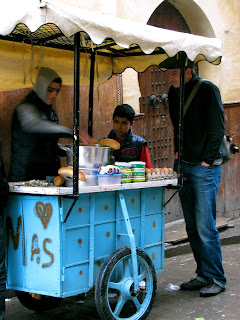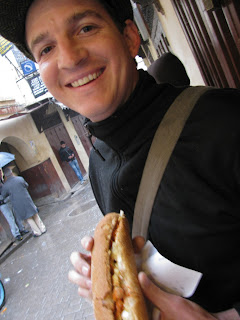 |
| They put us and another tourist couple on the bus half an hour early. For 29 minutes beggars and salespeople made their rounds, then the Moroccans got on the bus and we departed. |
On the recommendation of several travelers, the Byers Vagabonding Duo braved the stinky, dirty bus from Marrakesh to the seaside town of Essaouira. Billed as laid-back, and known for its surf-culture and
gnaoua music (
see YouTube video of gnaouas), we were really looking forward to our time there.
 |
| Dinner on our first night in Essaouira - Snack 24. |
 |
| The ambiance made up for the smelly, greasy food, and the dish-soap flavored tea glasses. |
On our first full day we headed straight for the port. Essaouira has been inhabited since prehistoric times, and at one point served as the main shipping port for Marrakesh. Its walls and ramparts are a testament to its prosperity, and the advantages it had with a harbor sheltered by the islands of Mogador.
Walking out of the walled medina and into the shipyard we were impressed that the active fishing industry far outweighed the tourist value. Boats up on blocks for repair or a new coat of sealant, men wrangling huge nets, and fishermen out in the tidepools in raincoats and
jelly sandals.
 |
| Fishermen manage their nets. The man entering the picture on the right is wearing an outfit that we saw throughout Morocco - jelaba, baseball cap, and yellow leather babouches (pointy-toed slippers.) |
Something worth noting about the walled medina's proximity to the ocean: it is very hard to get to the actual beach. We knew it was there, but how to get to it? We actually attempted to follow the medina wall around the city looking for a gate. No such luck.
 |
| We scaled this wall, only to find that there was no way to get down to the beach. |
In the end, we spied a boy climbing over a shorter section of wall, and determined to follow suit, not to be deterred by the piles of trash and reek of human waste.
On the other side of the wall we found a lovely beach, a large group of men playing soccer, and some fun tidepools to explore. When it was time for lunch we dug out the bag of prickly-pear fruits we had purchased from a street vendor.
 |
| The cactus fruit. |
 |
| Most of its thorns have been removed, but one still has to peel it carefully to get to the tasty insides. |
 |
| Similarly to a pomegranate, the fruit is filled with big seeds that have to be swallowed whole or spat out in a fit of giggles. |
 |
| The empty peel looks like an orchid. |
 |
| Sigh. Fruity carnage. |
The beaches were beautiful. Walking away from the medina toward the more manicured beach, we found soft beautiful sand, large hotels, a number of cafes and wind-surfing rental operations.
 |
| A snowy egret. You'll have to take our word for it that it has yellow feet. |
 |
| What's that in the distance? |
 |
| It's camels! Ha ha! |
On our way back from the beach we were wandering the streets looking for a hammam that the map said was out that way. It was not. However, our aimlessness drew the attention of a Moroccan man, Jamal. He approached us, as many had before, asking if we would like to ride an ATV. No, thank you. A camel? No, thank you. Horse? No, thank you. You need hotel? No.
And then came the turning point. Michael said, "We need an apartment." What!? Oh, no. Now this guy will never go away! Donica threw up her hands, and then crossed them firmly, assuming the You-Got-Us-Into-This-Situation-Now-Get-Us-Out stance. The conversation that ensued focused on our position as poor students (sort-of) and Jamal's assurance that he had just the thing, in a mix of English, French and Spanish.
Michael must have some intuition about Jamal, because it turned out that the apartment WAS just the thing. Two bedrooms, a small kitchen with propane burners and refrigerator, located in the newly developed part of town, and still within walking distance of the beach.
 |
| Having the apartment was even more of a blessing, because Donica came down with a nasty cold and hunkered down to watch one of three English TV channels: WWF, French News (yes, in English), and TopMovie (horror films) |
 |
| One of a few boys circulating the neighborhood selling sardines. |
 |
| Michael accidentally bought this sour stuff instead of milk. DO NOT put it in your coffee. Ugh. Instead he invented a fruity/yogurty mixture. |
Jamal turned out to be an interesting friend. We ran into him many times out and about. He kept saying that he wanted to take us to Jimi Hendrix's house in the neighboring town of Diabat. One night Jamal took Michael with him to his local hammam, and about scrubbed all of Michael's skin off.
On our last night in the apartment Jamal came over to hang out. He wanted to show us how to make a real tagine. Tagine is a special Moroccan dish that is served all over the place here; meat, vegetables, and a special spice mix. Jamal even took us out to shop for all the proper ingredients: lamb, onion, peas, potatos, cilantro, raisins, and a fancy mix of spices. You cook it all up in a special pot, called a tagine (who knew?)
 |
| Expertly browning the meat |
 |
| Cutting in the onions sliced very, very thinly |
|
 |
| We had the job of shelling the peas. Jamal did everything else. |
 |
| He made a sort of potato tower over everything, put the lid on and let it cook for an hour. |
 |
| After-dinner glow. I will definitely be making tagine again. Tagine a la Jamal. |
|
The next day a storm of pretty epic proportions blew in. Rather than brave the torrential rain, thunder and lightning, we stayed on another night. We had one more lovely day in Essaouira, cozied up in the house, reading books, drinking tea, and marveling at Mother Nature.
This was a great decision. The weather cleared up, we caught the bus to Marrakesh, the train to Fes, and twelve hours later...well, that's a story for another blog.























